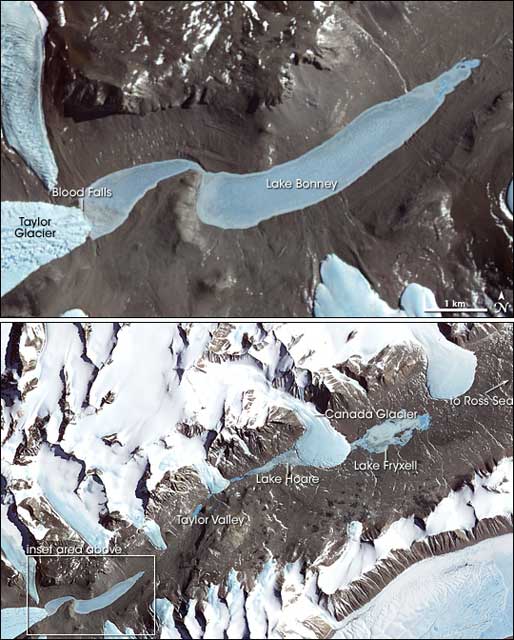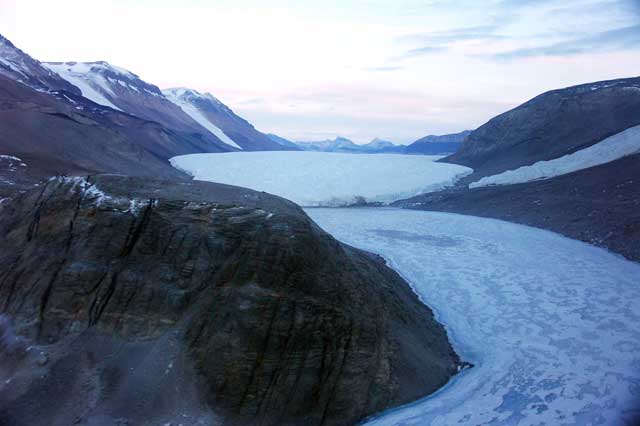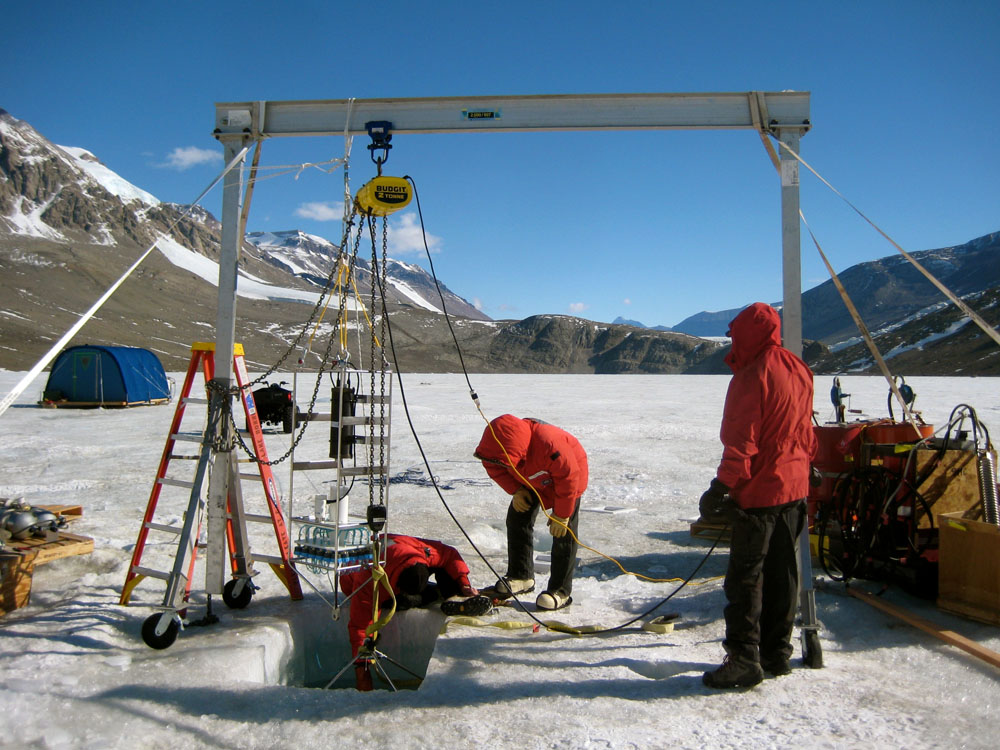|
Night watchInstruments in ice-covered lake will monitor biological activity in the winterPosted May 23, 2014
Antarctica is a notoriously difficult place to work in the best of seasons. Add the extreme cold and months-long darkness of the winter, and little research is done outside of the atmospheric and astronomy sciences at that time of the year. It takes a little ingenuity, in other words, to learn about what happens around the rest of the continent when the lights go out, particularly if you study the ice-covered lakes of the McMurdo Dry Valleys The lakes are an integral part of the region’s polar desert ecosystem. They catch the meltwater from glaciers that streams through the arid soils during the brief summer. Microorganisms such as bacteria and phytoplankton somehow eke out an existence in the cold and often highly saline waters, offering an ideal natural laboratory for studying not only extreme life on Earth but on frozen worlds like Europa. A wealth of data exists on that interplay between the lakes, soils and glaciers during the summer when scientists fly to and fro between the Dry Valleys and McMurdo Station. A couple of challenging and rare field deployments during Antarctica’s shoulder seasons – August and September in 1991 and 1995, as well as March and April in 2008 – added more details. [See previous article — In the cold of the night: Science team to extend seasonal work until April to study lake ecosystem in the McMurdo Dry Valleys.] The rest of the year is mostly a blank – an extrapolation based on more than 20 years of long-term summer observations. Until this winter. “The overall goal is to fill in the gap over those [other] months,” explained Hilary Dugan “Data obtained from the … research will provide unique insights into biological adaptation to cold and dark conditions, and provide us with a unique set of tools for future exploration of these environments,” Doran wrote in his proposal to the National Science Foundatio (NSF) Only a few lakes in the world have a permanent ice cover, and all but a few are in Antarctica, according to Dugan. That means limited options for studying extremophiles year-round in such a unique lake environment. “It’s amazing one of the first year-round records of lakes with ice will be from the Dry Valleys. I think that’s pretty significant,” Dugan said. The McMurdo Dry Valleys is one of about 26 Long Term Ecological Research (LTER) 
Photo Credit: NASA
A satellite view of Taylor Valley, below, and a closer view of Lake Bonney in image above.

Photo Credit: John Priscu/Antarctic Photo Library
The west lobe of Lake Bonney, with Taylor Glacier in the distance.
Dugan led the team during the 2013-14 summer field season that installed autonomous instruments in the largest and perhaps most well-studied of the lakes. The Autonomous Lake Profiling and Sampling (ALPS) stations, mounted in both the east and west lobes of Lake Bonney, use modified oceanographic equipment to make a suite of observations. The ALPS profilers record the usual parameters such as water temperature and salinity, but they also measure such things as photosynthetically active radiation (the solar radiation that photosynthetic organisms are able to use in the process of photosynthesis) and chlorophyll-a (a marker for phytoplankton, small plant cells) in the lake. The stations also have automated water and filter samplers to collect and preserve samples. Dugan said the team knows that the photosynthetic organisms go dormant in the winter when there is no light, but when or how quickly that happens is unknown. The hypothesis is that chemolithotrophs, microorganisms that get their energy from inorganic materials, rule during the long polar night. But the actual biogeochemical processes – if they are occurring – are mostly a mystery. “The sensors will pick up components that we may not even be aware of,” Dugan said. The configuration of the ocean profilers with other sensors and instruments is a first in the Antarctic, according to Doran, and not without its challenges. Cold is the most obvious one. And while the thick, permanent layer of ice on the lake makes a great platform for working, it’s also difficult to drill and deploy instruments through, particularly when they weigh more than 150 kilograms. The high salinity, or salt content, of the lake presents its own challenges. The bottom of the highly stratified lake is about four times more salty than seawater, which prevents the profiler from pushing all the way down through the water column along a cable attached to the surface. Providing enough power to operate the instruments in the winter limits its capabilities. “They’re designed for the ocean where your density gradient is minimal,” Dugan explained. “These lakes represent the extreme range of water bodies on Earth. …We’re testing the limits on some of this engineering.” Photo Credit: Liz Kauffman/Antarctic Photo Library
The ENDURANCE robot was deployed into Lake Bonney in 2008-09 to explore the lake.
The east and west lobes of Lake Bonney are essentially independent lakes, with different characteristics and influences. The western side of the lake, in particular, is fascinating because that’s where the Taylor Glacier and its weird feature known as Blood Falls Blood Falls results from the discharge of iron-rich, saline liquid that percolates from a briny subglacial pool somewhere upstream of the massive river of ice. The liquid oxidizes rapidly at the surface, giving the ice its distinctive bloodstained coloration. “[It] looks like [Blood Falls] is just a minor surface manifestation of a much bigger flow,” Doran said. Previous exploration of the lake by a robot called ENDURANCE, for Environmentally Non-Disturbing Under-ice Robotic ANtartic Explorer, led by Doran and colleagues, found evidence of subglacial discharge coming out from under Taylor Glacier all across the front. [See previous article — Exploring Bonney: ENDURANCE robot dives into ice-covered lake to produce 3-D map.] “We’re starting to see a lot of influence from Taylor Glacier into the lake, and where it’s coming in and how it’s coming in,” Dugan said. “That just makes it more interesting.” Peter Doran, University of Illinois at Chicago, Award No. 1340905 |



For USAP Participants |
For The Public |
For Researchers and EducatorsContact UsNational Science FoundationOffice of Polar Programs Geosciences Directorate 2415 Eisenhower Avenue, Suite W7100 Alexandria, VA 22314 Sign up for the NSF Office of Polar Programs newsletter and events. Feedback Form |



